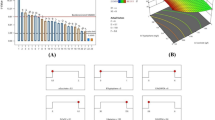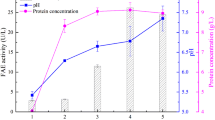Abstract
Cytochrome P450 (CYP, P450) 2C9 is one of three human microsomal CYPs in subfamily 2C that contribute extensively to the hepatic metabolism of therapeutic drugs. The enhancement of recombinant CYP2C9 expression of a transformed E. coli strain is essential for the development of an efficient large-scale bioprocess. The recombinant CYP2C9 production is influenced by various factors, especially the medium components. The aim of this study is to optimize the culture medium of the recombinant E. coli, to determine the influence order of 11 factors, and to improve the yield of heterologously expressed CYP2C9. Plackett–Burman (PB) design, a statistical methodology, was used to screen 11 nutrients and medium components for the production of human CYP2C9 from E. coli BL21(DE3)pLysS harboring plasmid pCW2C9dH in aerobic shaking flask cultures. The experimental data were subject to statistical analysis for calculating the regression coefficients. The matrix of PB design was also used to construct the series that is needed for grey relational analysis (GRA), an approach totally different from traditional statistical analysis used to calculate the relational grade between two sequence data, to determine the influence priority of 11 parameters. Influence priority: glycerol > δ-ALA > IPTG = ampicillin > chloramphenicol = inoculum density > peptone > thiamine > trace elements > NH4Cl > MgSO4. The coefficient for the individual factor estimated from PB design agrees the conclusion of GRA. This is the first report that combined two powerful analysis methods for the enhanced production of recombinant protein.
Similar content being viewed by others
References
Chen HH, Tsai PJ, Chen SH, Su YM, Chung CC, Huang TC (2005) Grey relational analysis of dried roselle (Hibiscus sabdariffa L.). J Food Process Preserv 29:228–245
Chen MY, Syu MJ (2003) Film analysis of activated sludge microbial discs by the Taguchi method and grey relational analysis. Bioprocess Biosyst Eng 26:83–92
Cheng D, Kelley RW, Cawley GF, Backes WL (2004) High-level expression of recombinant rabbit cytochrome P450 2E1 in Escherichia coli C41 and its purification. Protein Expr Purif 33:66–71
Deng JL (1989) Introduction to grey system theory. J Grey Syst 1:1–24
Duarte MP, Palma1 BB, Gilep AA, Laires1 A, Oliveira JS, Usanov SA, Rueff J, Kranendonk M (2005) The stimulatory role of human cytochrome b5 in the bioactivation activities of human CYP1A2, 2A6 and 2E1: a new cell expression system to study cytochrome P450 mediated biotransformation. Mutagenesis 20:93–100
Guengerich FP (2004) Cytochrome P450: what have we learned and what are the future issues? Drug Metab Rev 36:159–197
Guo Y, Breeden LL, Zarbl H, Preston BD, Eaton DL (2005) Expression of a human cytochrome p450 in yeast permits analysis of pathways for response to and repair of aflatoxin-induced DNA damage. Mol Cell Biol 25:5823–5833
Huang WD, Chen JC, Hsu MH, Yang ZW, Chang SS, Tsai YZ, Huang KY, Lu LC, Chen CC, Yang CM (2003) Grey relational analysis of the effect of climate factors on the satellite remote sensing brightness index of carpetgrass in Mt. Huangzui. Chin Agron J 13:59–66
Jansson I, Stoilov I, Sarfarazi M, Schenkman JB (2000) Enhanced expression of CYP1B1 in Escherichia coli. Toxicology 144:211–219
Jiang H, Morgan JA (2004) Optimization of an in vivo plant P450 monooxygenase system in Saccharomyces cerevisiae. Biotechnol Bioeng 85:130–137
Kagawa N, Cao Q (2001) Osmotic stress induced by carbohydrates enhances expression of foreign proteins in Escherichia coli. Arch Biochem Biophys 393:290–296
Kagawa N, Hori H, Waterman MR, Yoshioka S (2004) Characterization of stable human aromatase expressed in E. coli. Steroids 69:235–243
Mast N, Andersson U, Nakayama K, Bjorkhem I, Pikuleva IA (2004) Expression of human cytochrome P450 46A1 in Escherichia coli: effects of N- and C-terminal modifications. Arch Biochem Biophys 428:99–108
Mezentsev A, Mastyugin V, Seta F, Ashkar S, Kemp R, Reddy DS, Falck JR, Dunn MW, Schwartzman ML (2005) Transfection of CYP4B1 into the cornea increases angiogenic activity of the limbal vessels. J Pharmacol Exp Ther 315:42–50
Montgomery DC (2004) Design and analysis of experiments, (6th edn). John Wiley & Sons. New York ISBN 0-471-48735-X
Omura T, Sato R (1964) The carbon monoxide-binding pigment of liver microsomes. I. Evidence for its hemoprotein nature. J Biol Chem 239:2370–2378
Rodriguez-Antona C, Axelson M, Otter C, Rane A, Ingelman-Sundberg M (2005) A novel polymorphic cytochrome P450 formed by splicing of CYP3A7 and the pseudogene CYP3AP1. J Biol Chem 280:28,324–28,331
Studier FW (2005) Protein production by auto-induction in high density shaking cultures. Protein Expr Purif 41:207–234
Tan XR, Li YG, Chen MZ (2005) Applications of grey relational analysis in gastroenterology. World J Gastroenterol 11:3457–3460
Wang H, Li X, Xu BL, Xu WM (2004) Synthetical evaluation of promoting effect of some kinds of transdermal enhancers with grey relational cluster method. Zhongguo Zhong Yao Za Zhi 29:417–420
Wester MR, Yano JK, Schoch GA, Yang C, Griffin KJ, Stout CD, Johnson EF (2004) The structure of human cytochrome P450 2C9 complexed with flurbiprofen at 2.0-A resolution. J Biol Chem 279:35,630–35,637
Acknowledgments
We thank Dr E.F. Johnson (Department of Molecular and Experimental Medicine, The Scripps Research Institute, La Jolla, California 92037, USA) for kindly providing expression plasmid pCW2C9dH. This work is supported by 973 Program (2003CCA03400) of the Ministry of Science and Technology of China.
Author information
Authors and Affiliations
Corresponding author
Appendix
Appendix
Those systems that lack information such as structure messages, operation mechanisms, and behavior documents can be referred to as grey systems. GRA can be used to represent the grade of correlation between two sequences so that the distance of two factors can be measured discretely.
A so-called grey relational space contains several series: one is used as the fix reference series x 0, and the others are series x i to be compared as shown below
All numbers in the series should be pretreated to locate the value of each datum in [0, 1]. The pretreatment can be performed using the following approach,
where x * i (k) is the normalized value of each elements in each series.
An m × n matrix X can consist of m series
The elements in each row of the above matrix are subtracted by the elements of the reference series, thus another matrix Δ is obtained:
where Δ0j (k) = |x j (k)−x 0(k)|. Δmax is the elements of maximum value in the matrix, while Δmin is the elements of minimum value in the matrix. The grey relational coefficient γ 0j (k) can then be expressed as
where the value of the coefficient ζ is in [0, 1].
The grey relational grade is defined as the average of all grey relational coefficients, i.e.,
therefore, the influence sequence of the affecting factors of the system can be analyzed with the value of the grey relational grade.
Rights and permissions
About this article
Cite this article
Hao, D.C., Zhu, P.H., Yang, S.L. et al. Enhanced production of human Cytochrome P450 2C9 by Escherichia coli BL21(DE3)pLysS through the novel use of grey relational analysis and Plackett–Burman design. World J Microbiol Biotechnol 23, 71–78 (2007). https://doi.org/10.1007/s11274-006-9194-5
Received:
Accepted:
Published:
Issue Date:
DOI: https://doi.org/10.1007/s11274-006-9194-5




